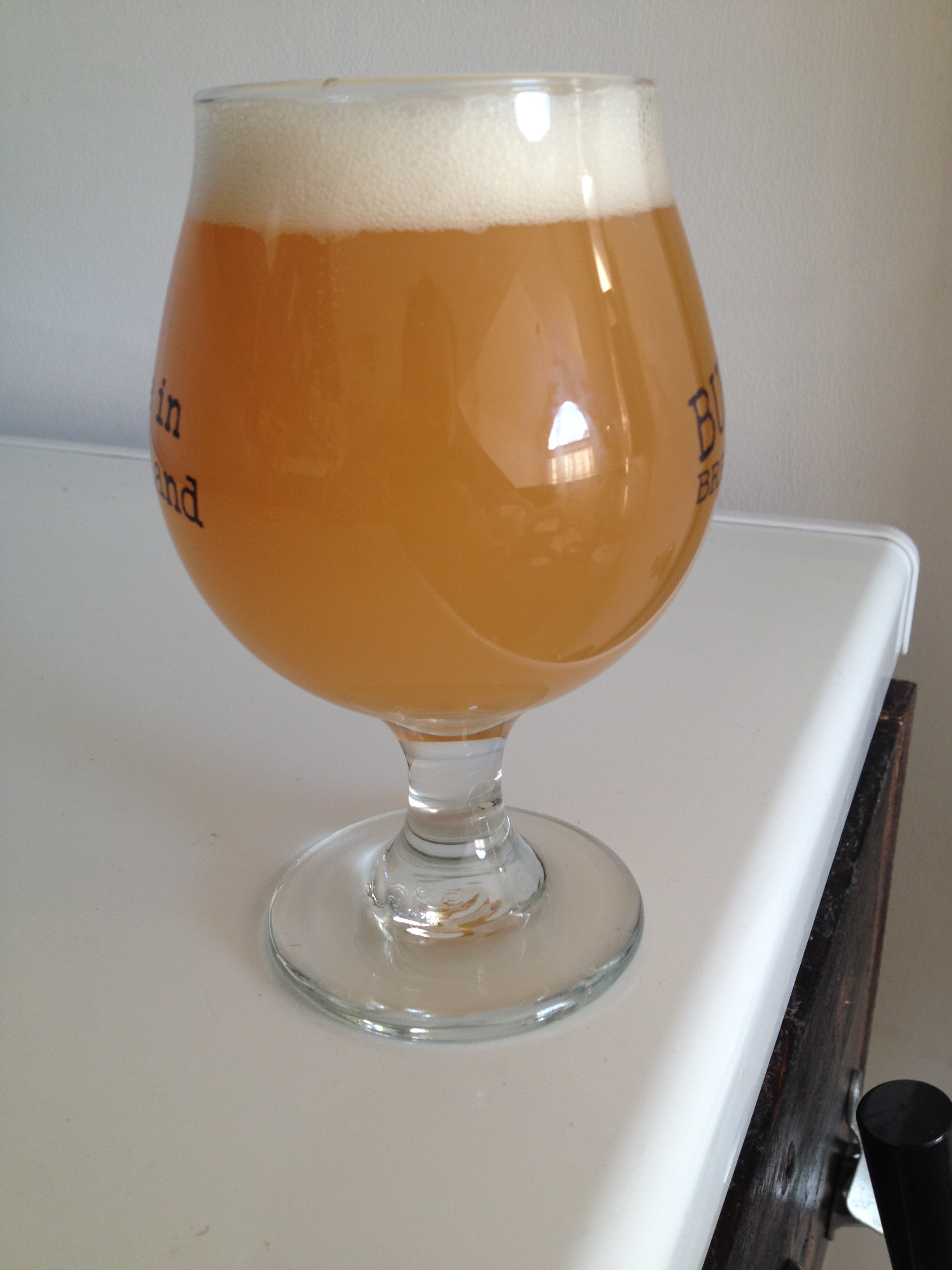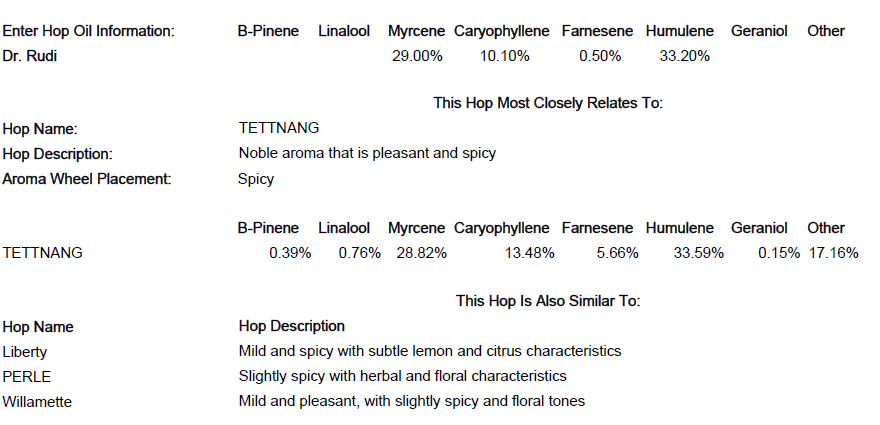
I love it when other homebrewers brew single hopped beers and post about their experiences. Commercial descriptions of hops are extremely helpful, but I’ve always found brewers direct experience with a hop extremely valuable in understanding how I might want utilize a variety or if I even want to at all. While it can be a tad bit boring to brew single hopped beers (and sometimes even more so to have 5 gallons on tap), it is by far one of the best ways for me to wrap my taste buds around a hop.
Dr. Rudi was released in 1977 by New Zealand’s Horticultural Research Centre and was once called the “Super Alpha,”1 despite having only a slightly above average alpha acid percentage (although this was 1977). Yakima Valley Hops describes the hop as tropical with notes of passion fruit, and peach. This description makes me think Citra and Galaxy! YCHHops describes Dr. Rudi as citrus, pine, and herbal. These are somewhat conflicting descriptors, almost sounding like they are describing two separate hops. I decided to run the oils of Dr. Rudi through a new experimental hop oils calculator I’ve been working on (image of results below). Essentially, the calculator works by entering in the known hop oils of any particular hop you are unfamiliar with and curious about trying (like Dr. Rudi) and it will calculate the hops that most closely resemble your chosen variety using hop oil data. I think this type of analysis could be useful to help formulate recipes with hops you haven’t yet brewed with. It might also be helpful when looking at new experimental varieties and trying to determine which ones you might want to order and experiment with. Hopefully I can put this calculator online soon, but for now I’m still working out the kinks. In this case, Dr. Rudi most closely resembles Tettnang, which is a far cry from the tropical, passion fruit, and peach aromas advertised by Yakima Valley Hops!
For this particular beer I decided to keep the grain build simple and used a New England IPA base to showcase Dr. Rudi. With both a healthy dose of whirlpool additions and two solid dry hop additions, including one in the keg until it kicked, there should be no trouble getting a nose on Dr. Rudi!
Experimental Hop Calculator Results

Recipe Details
| Batch Size | Boil Time | IBU | SRM | Est. OG | Est. FG | ABV |
|---|---|---|---|---|---|---|
| 5.5 gal | 45 min | 66.7 IBUs | 3.7 SRM | 1.055 | 1.017 | 4.9 % |
| Actuals | 1.053 | 1.015 | 5.0 % | |||
Fermentables
| Name | Amount | % |
|---|---|---|
| Organic 2-Row | 10.75 lbs | 80.19 |
| Oats, Flaked | 2 lbs | 14.92 |
| Organic Spelt Flour | 8 oz | 3.73 |
| Acid Malt | 2.48 oz | 1.16 |
Hops
| Name | Amount | Time | Use | Form | Alpha % |
|---|---|---|---|---|---|
| NZ Dr. Rudi | 35 g | 45 min | Boil | Pellet | 11 |
| NZ Dr. Rudi | 70 g | 15 min | Aroma | Pellet | 11 |
| NZ Dr. Rudi | 84 g | 0 min | Dry Hop | Pellet | 11 |
Miscs
| Name | Amount | Time | Use | Type |
|---|---|---|---|---|
| Calcium Chloride | 4.40 g | 60 min | Mash | Water Agent |
| Gypsum (Calcium Sulfate) | 3.90 g | 60 min | Mash | Water Agent |
| Calcium Chloride | 2.90 g | 60 min | Mash | Water Agent |
| Gypsum (Calcium Sulfate) | 2.60 g | 60 min | Mash | Water Agent |
| Irish Moss | 1.00 tsp | 15 min | Boil | Fining |
| Yeast Nutrient | 0.50 tsp | 15 min | Boil | Other |
Yeast
| Name | Lab | Attenuation | Temperature |
|---|---|---|---|
| London Ale III (1318) | Wyeast Labs | 73% | 64°F - 74°F |
Mash
| Step | Temperature | Time |
|---|---|---|
| Mash In | 157°F | 60 min |
Fermentation
| Step | Time | Temperature |
|---|---|---|
| Primary | 3 days | 68°F |
| Aging | 71 days | 4°F |
Notes
| Water Profile: R/O w/ Gypsum .75 grams/gallon Calcium Chloride .85 grams/gallon 111ppm Sulfate | 112ppm Chloride Mash pH: 5.43 Final Beer pH: 4.22 A couple notes about the recipe/process, this was the 5th generation of London Ale III that was 24 days old with no starter. This beer finished fermenting extremely quickly, after about 3 days it looked to be finishing up. Strangely, this is the first time I’ve had London Ale III krausen drop so quickly, that I believe was caused by a slight accidental temperature drop around day 4 because of cold temperatures in DC. This didn’t seem to cause a problem in the ferment however. I dry hopped the beer in two stages. First with 42 grams of Dr. Rudi on day 3 of fermentation loose in primary. Next I dry hopped with 56 grams of Dr. Rudi in a fine mesh bag in a purged keg, where the hops remained until the beer kicked. |
Download
| Download this recipe's BeerXML file |
Results
As expected, this beer was cloudy, but not as bad as some previous beers I’ve fermented with London Ale III and lots of flaked oats. It poured with an OK head, but unfortunately it quickly disappeared. This lack of head retention seems to be a trend with beers I’ve made with a high percentage of flaked oats. Most likely because of the total protein to total fat content? For comparison purposes look at the following flaked grains protein:total fat ratios, oats lead the pack.
Protein(grams):Total Fat (grams)
Flaked Oats | 6:3
Flaked Quinoa | 4.3:2
Flaked Spelt | 6:1.5
Flaked Rye | 4.0:1
Flaked Kamut | 6:0.5
Aroma Dr. Rudi reminded me of a lot of lemon poppy seed muffins with a hint of banana layered in there that became more apparent as the beer warmed up. Dr. Rudi definitely has some hop spice to it as well. Not spicy in a hot or extreme peppery way, but more of a mint or herbal spiciness. I’d have to disagree with the Yakima Valley Hop description, Dr. Rudi leans more towards herbs and mellow fruits than tropical. The experimental hop calculator was pretty accurate for this hop when looking at the commercial descriptions for Tettnang and Liberty (pleasant, spicy, subtle lemon, and mild).
Overall Dr. Rudi is lacking the big fresh citrus and tropical aromas I’d prefer in a beer of this kind. I might consider tyring this hop blended with another (possibly NZ Motueka) in a tart saison to double down on the lemon qualities but make more complex secondary flavors and aromas.
The Mouthfeel is nice and soft with a medium to medium-low body (I’d prefer a little more body). There is a slight grainy/crackery finish in this beer. I haven’t heard very many others mention it, but I have continually gotten this grainy aftertaste that lingers in beers fermented with London Ale III, sometimes I’m afraid at the cost of slightly hiding hop flavor.

-610x915.jpg)
I have been playing with london III as well. I have also been getting that grainy after taste as well in all of lighter colour beers (dark beer it seems much harder to detect). I have persisted, but this after taste is probably going to stop me from using this yeast.
I also have been not preferring LAIII, at least for the first month or so. Once the beer has aged, it seems to get a lot better. Try WLP095 or Conan for a better yeast option.
I know this is an old thread, but a couple things.. Firstly could the grainy thing be from the spelt? I find spelt gives much more wholegrain bread kind of taste than wheat..
Second I notice you and thousands of people leave hops in the keg.. I feel I’m going mad at how much I notice the vegetal taste of hops in the keg after 48hrs! Most common way I have spoiled good beer.
Interestingly hops added during fermentation don’t do this at all. I also wonder if it’s co2 or pressure related.
The grain quality could be from Spelt, I know when I make sourdough made with a high percentage of spelt I get a strong box of Wheaties aroma. Sounds like leaving hops in the keg isn’t your thing! I’ve done it countless times, when it gets too “green” I tend to think that’s more of an issue with over dry hopping than contact time. After a few days most of what the hop has to extract is complete, So it seems unlikesly that extended time in a keg would continue to extract harsh tasting polyphenols for example, which peak around 3 days.